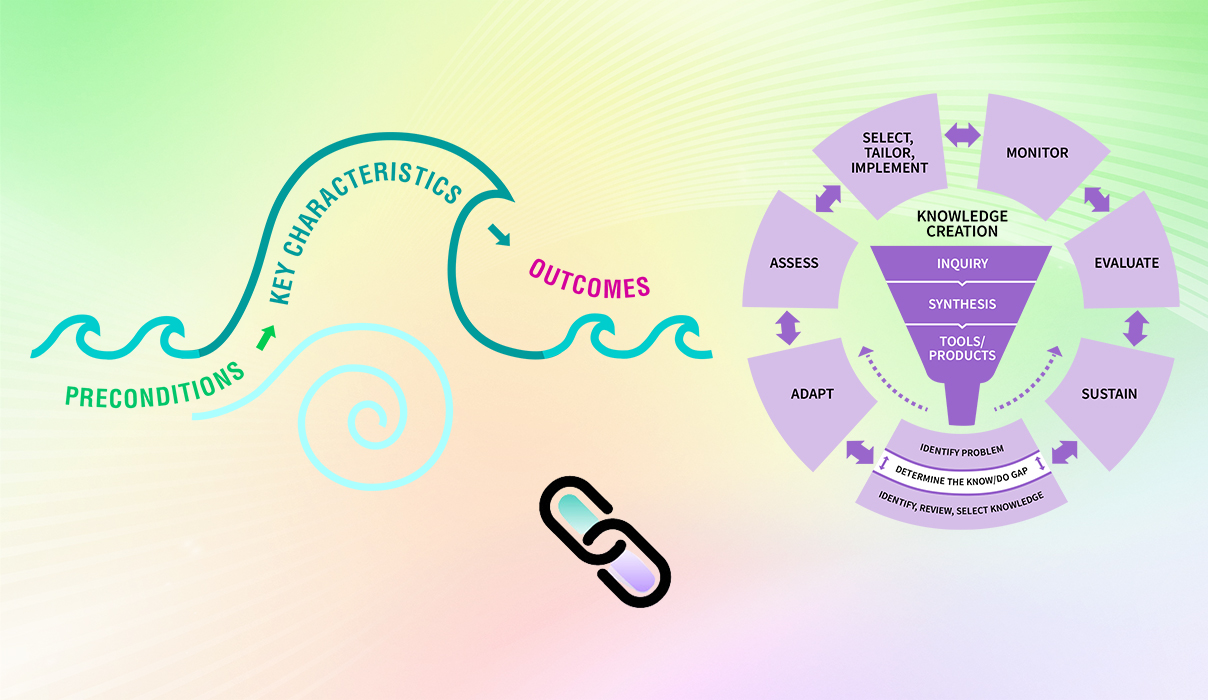Change is valued and necessary
Index
The "Change is valued and necessary" element – one of the three preconditions of a social movement – reflects the notion that social movements are driven by a desire to advance common values. In this section, you will learn how values play a central role in social movements. And as a change agent or part of a change team, you'll find out how to gauge whether change is valued by others.

What is this element?
In social movements, people come together to achieve change to improve outcomes, such as enhancing service provision and access, providing safe reliable options, addressing inequities, and/or advocating for at-risk individuals (Arnold et al., 2018; Bate et al., 2004b; Carson-Stevens et al., 2013; Grinspun, 2018; Waring & Crompton, 2017). This change is driven by values.
Change never occurs in isolation. It is always impacted by contextual elements, such as the local setting or the timing when the change occurs. The push for change in social movements is influenced and shaped by the local social system – the individuals who are working together, their relationships and interactions – and the areas of change that the social system deems as prioritized and valued.
How much value is placed on the change by the social system can be either a facilitator or a barrier (Rogers, 2003):
- When change is valued and aligns with people’s norms, beliefs and culture, it can be a facilitator that positively speeds uptake and spread.
- When change is not valued, supported or prioritized within the social system, it can be a barrier - whether it is rejected outright or fails to make any progress or gain momentum.
Why is this element important?
- Change that is valued and necessary can positively impact individual trajectories. This is especially true when areas of inequities are targeted and when values of fairness or justice are integrated, such as accessibility and inclusivity.
- Change that is valued and necessary acts as a driver for action. Shared concerns or strongly desired changes represent areas that people believe need further enhancements, or where current practice needs to be stopped or accelerated. When change is valued and necessary, it creates timeliness and urgency for action.
- People are attracted to change that they value and view as necessary. When the change aligns with people’s intrinsic values, it is personally meaningful and drives their need to become involved and invested in the change. This acts as a precursor for being ready to take action through a social movement.
SOURCES: del Castillo et al., 2016; Kapilashrami et al., 2016; Ruglis and Freudenberg, 2010.
Considerations for getting started
View our worksheet of guiding questions to determine whether your change is valued and necessary by others.
The answers to the questions in the above linked worksheet can help to determine overall support for the change, and whether there is enough energy to start moving the change forward to action (Arnold et al., 2018; del Castillo et al., 2016).
Accelerate Your Success: The Knowledge-to-Action Framework’s "Adapt knowledge to local context" action cycle phase includes an assessment of the people who can directly or indirectly influence your change initiative. Seeking stakeholder input on whether change is valued and necessary can help change teams gauge the support and receptivity for change and strengthen their ability to later mobilize for action.
Case studies

Valuing the need for hospice and palliative care services
Advocacy for humane death and dying care practices led to the valuing and realization of hospice and palliative care services in South Australia in the 1990s (Elsey, 1998). Early hospice and palliative care advocates pressed for comprehensive community services provided by knowledgeable, humane and compassionate care providers who understood and supported the need for an alternative to medical practices in this area.
Advocates also recognized the need for funding, legislation, support of relevant volunteer organizations, and capacity-building in health professionals to ensure effective delivery of hospice and palliative care services.

Rooting the Kahnawake Schools Diabetes Prevention Project in Indigenous values
The Kahnawake Schools Diabetes Prevention Project (ksdpp.org) in the First Nations reserve of the Mohawks of the Kahnawake in Quebec, Canada aims to prevent type 2 diabetes in Kahnawake by empowering community members to care for their health. Project leaders were informed at the outset by evidence that demonstrated a two-fold higher risk of diabetes and diabetes-related complications in adults (Tremblay et al., 2018).
To be meaningful for community members, the change was rooted in the values and traditions of Kanien’kehá:ka beliefs, incorporating a holistic approach of spiritual, emotional, physical and mental dimensions that reflect wellbeing. The project’s focus aligned with the value of protecting and promoting the health of future generations. By linking the change in values, families and other community members were more invested in the cause.
Linking this precondition to other framework components

Linking to other elements of the Social Movement Action Framework
Each of the elements of the Social Movement Action (SMA) Framework is dynamic and interrelated. For example, change that is valued and necessary is linked to receptivity to change because it indicates that there is agreement amongst some a group of individuals of the value and need for change. This is also linked to knowledge of social movement actions because it gives change teams the ability to understand how change, when valued, can act as a powerful driver for action.
This can also:
- help change teams to position or frame an issue in ways that can resonate with others by engaging their hearts and minds
- link to individuals’ intrinsic motivation and commitment to engaging in the change
Linking to the action cycle phases of the Knowledge-to-Action Framework
You and your change team’s capacity in social movement actions may be enhanced or accelerated by adding in some of the action cycle phases of the Knowledge-to-Action (KTA) Framework. There can be many points of connection between the two frameworks. Here are two examples for you to consider:
- Adapt knowledge to local context: To ensure that the identified problem can be addressed effectively, you and your change team should consider contextual factors such as the presence of formal and informal leaders, the attitudes of those who will affect or be affected by the change, and the availability of resources. These considerations will help you to determine whether there is an opportunity for change.
- Assess barriers and facilitators: Identify and assess the barriers and facilitators that will help the change or hinder it. Identifying these important factors can help you and your change team to determine whether the change is timely.
For more discussion about the dynamic links between the elements of the SMA Framework to one another and to the KTA Framework, see the section "Two complementary frameworks".
More resources
Want to learn more about using the strategies of the SMA and KTA frameworks to support your change? Sign up for the RNAO Best Practice Champions training course.


